Until the beginning of the fifteenth century illuminating manuscripts in the Kingdom of Poland, as elsewhere in Europe, was the domain of clergy. Over the century this specialty went beyond cloisters and started to be also an occupation of laymen. In the late fifteenth century Cracow was the main centre of illumination production in the Kingdom. This period seems to be crucial due to the changes caused by the invention and development of the printing press. It enabled shorter, wider and cheaper book production and, at the same time, a high demand for printed books, not only liturgical ones, but also these which served educational purposes. Consequently, new groups of craftsmen, who bound and decorated books, appeared.
During the fifteenth century, the boundaries between different specializations of artisans were still not very clear. Sometimes a cathedralis, whose main task was to write a book, was simultaneously a bookbinder and illuminator (Lewicka-Kamińska 1972: 50). This tradition seems to be continued till the end of the century. Those who bound books were often also the authors of the decorations. Therefore, knowledge about the bookbinders of that period can be helpful in the research on illuminators.
It is estimated that about 30 bookbinders were active in the fifteenth-century Cracow. They worked in scriptoria at Wawel for the cathedral and for the royal court, but also at the University (Lewicka-Kamińska 2015: 406). Presumably, the situation of illuminators was similar. The phenomenon of layman bookbinders, and probably illuminators, was closely connected with the appearance of private and institutional libraries. The academic centres, such as Cracow, were great markets because of the need for educational books. At the University of Cracow, as in other European centres, students, both bachelors and masters, worked as bookbinders. They collected the most necessary tools in their dormitories where they worked (Lewicka-Kamińska 2015: 400).
The knowledge of the representatives of this group is still insufficient. Among many anonymous book’ decorators, two names emerged: Valentinus of Pilzno and Jakub Jeżowski. Valentinus started his studies at the University of Cracow in 1474, got his Bachelor’s degree (baccalaureus) in 1477 and Master’s degree (magister) in 1479. He was an active bookbinder and illuminator till his death in 1486. Anna Lewicka-Kamińska called him the most talented Cracovian bookbinder of this period, whose workshop existed till the end of the fifteenth century. The author claimed that Valentinus must have had assistants of great abilities due to the equal technical and artistic level of the workshop’s production (Lewicka-Kamińska 1974: 265). This assumption can be confirmed by the statement that the bookbinders did not work alone, but were supported by their colleagues or even had their own workshops where the tasks were divided; hence, decorations in one book could be made by different hands (Miodońska 1993: 98-99).
Valentinus’ activity was connected closely with the University because he bound and decorated his colleagues’ and professors’ books. One of them was Andrzej of Łabiszyn (d. 1498), the professor of canon law and theology and the rector of the University. Eight of incunabula which belonged to him were bound and decorated by Valentinus (today in the Jagiellonian Library: Inc. 550-551, Inc. 669, Inc. 829, Inc. 1047, Inc. 1106, Inc. 1163, Inc. 1241, Inc. 1879; Szelińska 1966, 147-151; Lewicka-Kamińska 1974: 266; Wagner 2016: 120). He donated three manuscripts and twenty three incunabula to the Library of Collegium Maius, today’s Jagiellonian Library (Zathey, Lewicka-Kamińska, Hajdukiewicz 1966: 125).
Due to his activity as a bookbinder and illuminator Valentinus must have known the technical processes of making a book from different angles. Moreover, he was thought to be a bibliophile, who gathered books which were decorated and bound in his own workshop. Two examples preserved in the Jagiellonian Library are known: Avicenna’s Canon medicinae (shelf-mark Inc. 669), donated to the University by the owner and Margarita poetica by Albertus de Eyb (shelf-mark Inc. 446) which was provided with an inscription: Valentini liber (Lewicka-Kamińska 1974: 271).
The artisan’s name appeared also in another copy of Canon medicinae kept in the Jagiellonian Library (shelf-mark Inc. 670). Inscription on page 471, written in red lead, reads: Per Valentinum illuminatum, magistrum arcium cum stetit in bursa Hierusalem per sex dies tempore quadragesimali Anno domini 1480 et introligatus per eundem in C[racovia]. This very rare case of signing work by Cracow illuminator gives us a lot of evidence; it proves the double role of Valentinus (illuminator and bookbinder), the date (six days, during Lent in 1480) and place of creating the book as well as the existence of a scriptorium at the University of Cracow where books were written, decorated and bound by students (Ameisenowa 1958: 135). This workshop could have been located in Jerusalem dormitory, mentioned in the inscription, at Gołębia street. In 1910, nearby this place, an impressive collection of bookbinders’ stamps, dated to the fifteenth and sixteenth century, was found (Lewicka-Kamińska 1974: 270-271).
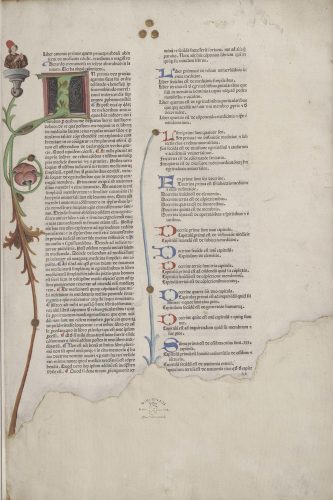
The printed text of Canon medicinae was filled in with many blue and red letters, simple in form, but at a high technical level. Initial I was composed of green acanthus leaves on a black background and closed in a pink frame. The letter was accompanied by the bust of a man in a red hat, sitting on a grey console. Ameisenowa noticed the realistic way of representing the figure’s face (Ameisenowa 1958: 135). The repetitive motive in Valentinus’ works were the three beads located on the margin. In this case they were painted in gold (fig. 1), whereas in another copy of Canon medicinae, next to initial F, pink, green and blue paints were used (fig. 2).
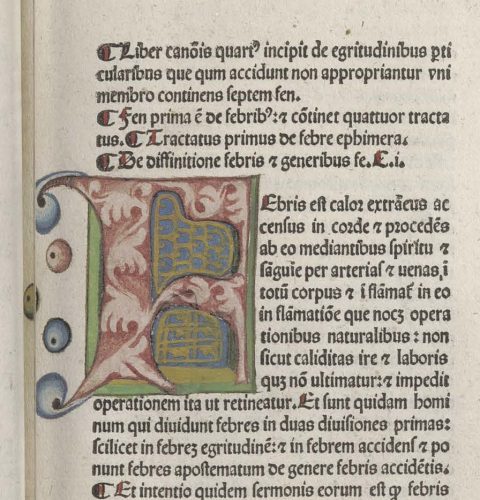
According to Ameisenowa, one of the earliest incunabula decorated by Valentinus was the example of Catholicon by Johannes Balbus de Janua held in the Jagiellonian Library in Cracow. It was printed in Mainz in 1460. The initials and margins ornaments, made by Valentinus, represented typical stylistic features of his work. The letters were composed of soft acanthus leaves or, rarely, interlocking plants, while their inner side was filled in with yellow or golden zigzag pattern or diagonal lattice (fig. 3). Another characteristic feature was the use of minium as well as painting the initials in red and azure. The ornaments on margins consisted of long acanthus-like leaves which ended with long foliated scrolls. The wide range of colours used in this example included brown, azure, light blue, carmine, scarlet, maroon, two different hues of green and grey as well as gold, both liquid and golden leaf.
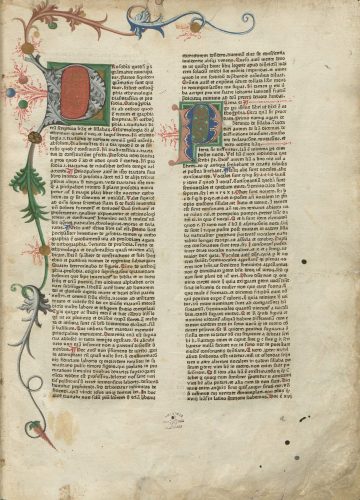
It seems that Valentinus was better in writing initials and rubrics than in painting ornaments or miniatures. An example of his more complex work was the one which belonged to the aforementioned example of Canon medicinae. It depicts Avicenna at an ill man’s bed, surrounded by seven other figures (fig. 4). A simple composition was enclosed in a green frame while people were distinguished by colourful robes. Valentinus’ illuminations were described as rather conservative and not diversified, especially in comparison with some other anonymous Cracovian decorations made in the 1480s or the ones created by Jakub Jeżowski.
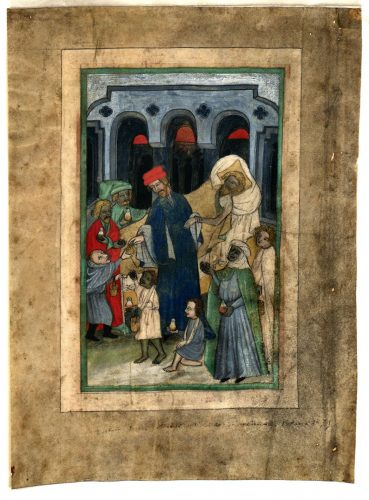
Jakub Jeżowski was a nobleman, the son of Stanisław of Jeżów, a student of the Cracovian Academy, illuminator, bookbinder and cathedral psalmist. Similarly to Valentinus, Jeżowski bound and decorated incunabula for the Academy’s professors. It was evidenced that he worked at least for three years for Piotr Świętopełk of Zembrzyce, professor of theology (d. 1497; Miodońska 1967: 107). He was a donor of 3 manuscripts and 202 incunabula to the Collegium Maius Library (Zathey, Lewicka-Kamińska, Hajdukiewicz 1966: 125).
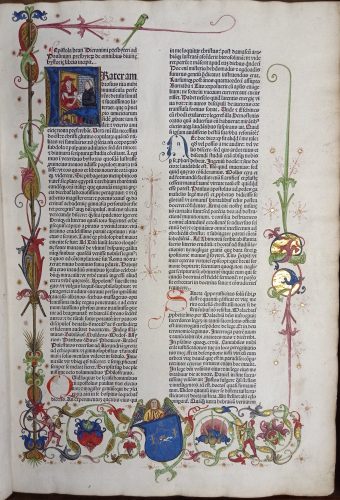
Decorations in the copy of the first part of Biblia Latina were ascribed to Jeżowski on the basis of the monogram .I. .I., visible on the coat of arms (fig. 5). In turn, the illuminations in the copy of the second part of Biblia Latina were attributed to him on the basis of stylistic features. In both examples the ornamentation was developed more than in Valentinus’ works. The main difference was the complex composition. Some initials were filled with the scenes, for example: initial F with Saint Jerome or initial B with David with a harp (fig. 6). Furthermore, purely decorative elements, such as a medallion with Creating of Eve as well as birds, human figures or an angel, entangled in the floral motives on the margins, appeared (fig. 7).
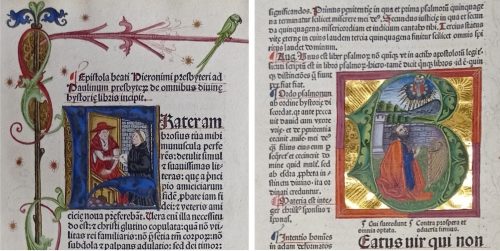
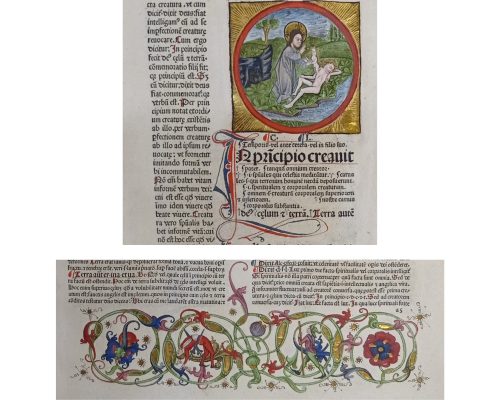
Among many anonymous authors of illuminations, Valentinus of Pilzno and Jakub Jeżowski were two documented names of incunabula illuminators, who worked for the community of the University of Cracow in the late fifteenth century. The ornaments which they produced represented various styles and different levels of development; nevertheless, they continued earlier tradition of manuscript decorations, characteristic for this region and time. Illuminations made in Cracow by this generation of craftsmen had a distinct influence on the style of incunabula decorations created in the first half of the sixteenth century.
Quoted literature:
Ameisenowa, Zofia, 1958. Rękopisy i pierwodruki iluminowane Biblioteki Jagiellońskiej [The manuscripts and illuminated incunabula in the Jagiellonian Library], Wrocław – Kraków: Zakład Narodowy im. Ossolińskich.
Lewicka-Kamińska, Anna, 1972. „Rzut oka na rozwój oprawy książkowej w Polsce” [The development of the bookbinding in Poland]. Roczniki Biblioteczne, vol. 16, Wrocław: Państwowe Wydawnictwo Naukowe, pp. 49-68.
Lewicka-Kamińska, Anna, 1974. “Walenty Lis z Pilzna, introligator krakowski XV wieku” [Valentinus of Pilzno, Cracovian book-binder of the fifteenth century]. Roczniki Biblioteczne, vol. 18/1-2, pp. 265-273.
Lewicka-Kamińska, Anna, 2015. “Dzieje rzemiosła introligatorskiego” [The history of the craft of bookbinding], edited by Jacek Patryka. Terminus, vol. 17 (2015), n. 3 (34), Kraków: Biblioteka Jagiellońska, pp. 387-420.
Miodońska, Barbara, 1967. Iluminacje krakowskich rękopisów z I połowy w. XV w Archiwum Kapituły Metropolitalnej na Wawelu [The illuminations of the Cracow manuscripts of the first half of the 15th century in the Archives of the Cracow Cathedral Chapter], Kraków: Ministerstwo Kultury i Sztuki, Zarząd Muzeów i Ochrony Zabytków.
Miodońska, Barbara, 1993. Małopolskie malarstwo książkowe: 1320-1540 [Illuminated books in Małopolska], Warszawa: Wydawnictwo Naukowe PWN.
Szelińska, Wacława, 1966. Biblioteki profesorów Uniwersytetu Krakowskiego w XV i początkach XVI wieku [The libraries of the professors of the University in Cracow in the 15th and 16th century], Wrocław: Zakład Narodowy im. Ossolińskich.
Wagner, Arkadiusz, 2016. Superekslibris polski: studium o kulturze bibliofilskiej i sztuce od średniowiecza do połowy XVII wieku [The Polish supralibros. The study on bibliophile culture and art from Medieval Ages up to the mid-17th century], Toruń: Wydawnictwo Naukowe Uniwersytetu Mikołaja Kopernika.
Zathey Jerzy, Lewicka-Kamińska Anna, Hajdukiewicz Leszek, 1966. Historia Biblioteki Jagiellońskiej [The history of the Jagiellonian Library], vol. 1, Kraków: Uniwersytet Jagielloński.